

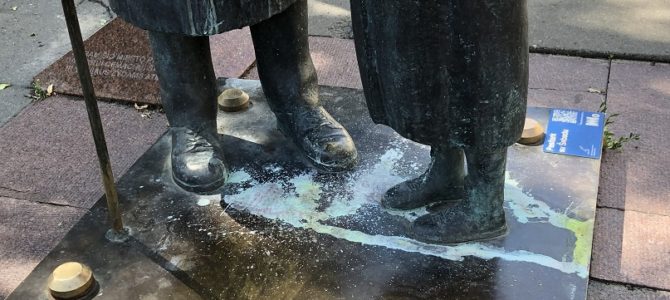
Tsemakh Shabad Statue Vandalized
The statue made by Lithuanian sculptor Romualdas Kvintas ensemble featuring Vilna Jewish doctor Tsemakh Shabad–the prototype for the Dr. Aybolit character in children’s poems and stories by the Russian writer Korney Chukovsky–and a child was vandalized with acid or paint.
The attack was the second over the weekend on Jewish monuments in the Vilnius Old Town. On June 26, the day before, the monument to the Vilna Gaon was also vandalized, also using acid or paint.
The Tsemakh Shabad was vandalized before soon after its unveiling in 2007 using acid. Some in the Lithuanian media are speculating the attacks are intended to mirror the wanton destruction of statues in the USA and UK by mobs. Meanwhile Lithuanian Nazi leader and Holocaust perpetrator Jonas Noreika’s shrine at the very center of Vilnius remains unharmed and under 24-hour surveillance by video cameras. Recently news media have reported on a repeat-offender intent on making her mark on statues around Vilnius even before the Black Lives Matter mass hysteria swept the United States. The elderly primary school teacher was arrested last year after police reviewed video surveillance showing her throwing red paint on an installation at Vilnius’s Lūkiškės Square intended to commemorate Lithuanian anti-Soviet partisans.
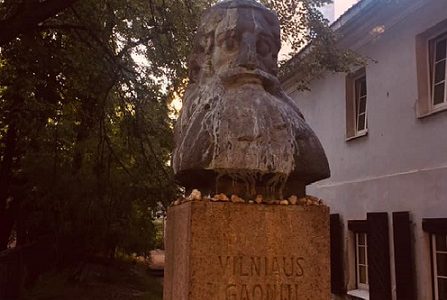
Vilna Gaon Monument Vandalized June 26
That statue commemorating the notional residence of the Vilna Gaon and the shulhoyf where the Great Synagogue and a number of other shuls once stood, built around the Gaon’s residence, was vandalized on June 26 using acid.
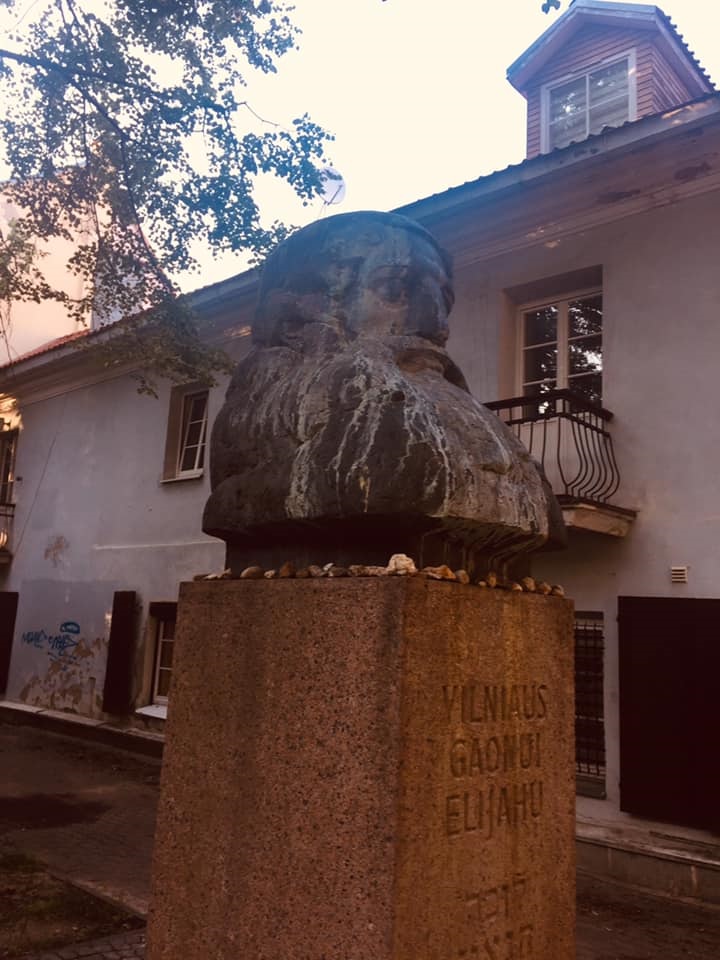
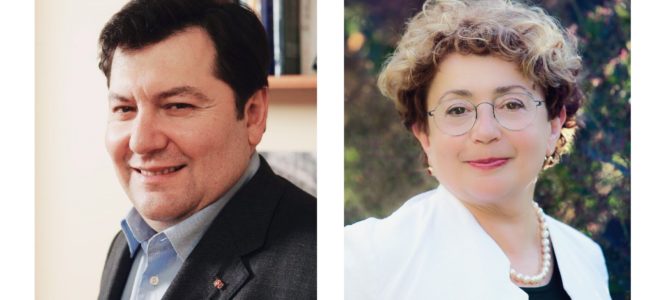
Don’t Speak in Our Name, Mr. President of the Russian Federation
We read the article “The Real Lessons of the 75th Anniversary of World War II” by Russian president Vladimir Putin in the American conservative magazine National Interest and reprinted by media representing the Russian opposition and pro-government position.
We feel the need to share our thoughts with readers on the fate of Jews, citizens of Lithuania, as red totalitarianism was replaced by brown totalitarianism in our country.
Many of my relatives, those of the chairwoman of the Lithuanian Jewish Community and those of many citizens of Litvak origin were imprisoned in the Stutthof (liberated by the USSR) and Dachau (liberated by American forces) concentration camps. My mother and Faina Kukliansky’s mother miraculously survived Stutthof.
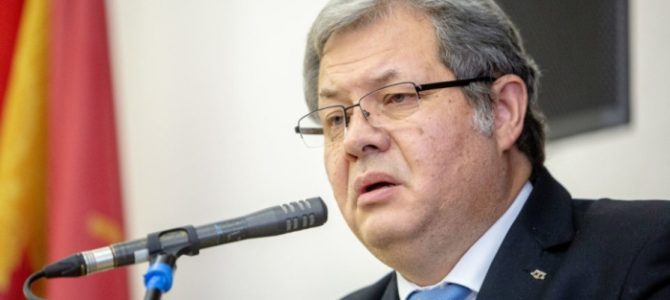
New Genocide Center Director
The Lithuanian news site 15min.lt reports Teresė Birutė Burauskaitė has been replaced as director of Lithuania’s Orwellian Center for the Study of the Genocide and Resistance of Residents of Lithuania by Adas Jakubauskas, the 55-year-old chairman of the Union of Lithuanian Tatar Communities. Last week parliamentary speaker Viktoras Pranckietis called for replacing Burauskaitė. The director is appointed by vote of parliament to a 5-year term. Jakubauskas’s candidacy was put forth by the Lithuanian parliament’s Battles for Freedom and State Historical Memory Commission, whose member Arūnas Gumuliauskas recently promised to present a resolution to parliament claiming the Lithuanian state and people were guiltless in the Holocaust because they were both occupied at the time. The new director of the Genocide Center faced stern questioning by MPs during his confirmation process, with former Genocide Center historian and now conservative MP Arvydas Anušauskas digging into the Lithuanian Tartar community’s financial ties with Tartar communities in Russia.
Anušauskas once hosted a history program on state television and once spent more than an hour exploring the idea the Nazis and the Soviets staged the Lietūkis garage massacre in order to defame Lithuanians.
Tartars are an ethnic minority in Poland, Lithuania, Belarus, Ukraine, Russia and elsewhere who mainly adhere to Sunni Islam. There are major communities of Tartars in Tartarstan and in the Crimea.
The Center for the Study of the Genocide and Resistance of Residents of Lithuania has consistently defended Lithuanian Nazis including Kazys Škirpa and Jonas Noreika.
Full story in Lithuanian here.
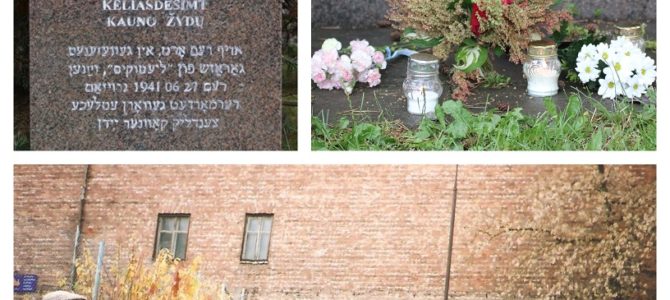
Kaunas Jewish Community Invites You to Remember Victims of Lietūkis Garage Massacre
The Kaunas Jewish Community will hold a commemoration of the victims of the Lietūkis garage massacre at Miško street no. 3 at 4:00 P.M. on June 26. Joris Rubinovas will perform Maurice Ravel’s Kaddish and Gabrielė Jocaitė will perform a song in member of the victims. The public is invited and encouraged to attend. Following the ceremony we will move to the Slobodka (Vilijampolė) Jewish cemetery on Kalnų street and then the Žaliakalnis Jewish cemetery on the Radvilėnų highway.
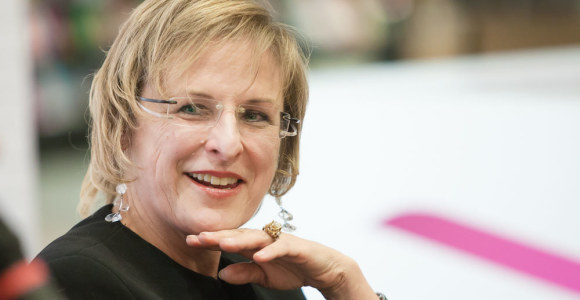
How It Happened
Lithuanian writer Rūta Vanagaitė and German historian Christoph Dieckmann presented their new book called “How Did It Happen?” at a launch ceremony held at the Choral Synagogue in Vilnius on June 25.
Dieckmann delivered what amounted to a lecture on the topic of the Holocaust in Lithuania lasting about one hour, and proposed rejecting some accepted Holocaust terminology as judicial rather than historical. He said looking through the lens of ethnicity creates a false picture, even though the actors at the time did so. He also said the idea of perpetrators, victims, collaborationists and so on should be revisited and the true picture is more complex, with people collaborating with the Nazis at one point and the same people resisting them at another. He said the grey cover of the Lithuanian-language edition of the book reflects this ambiguity.
Lithuanian Jewish Community chairwoman Faina Kukliansky served as moderator and challenged Dr. Dieckmann’s seeming rejection of the legal aspects in favor of the historical truth. Dieckmann responded saying so much of the narrative is dominated by legal defense and prosecutorial arguments that it’s difficult to see what really happened.

Four Historical Shames Which Afflict Us Lithuanians
by Arkadijus Vinokuras DELFI.lt
History forms the collective experience and mentality of the generations of today and tomorrow. Running away from the unpleasant facts of history which are perceived as shameful, the aspiration of denying or justifying them, leads to a psychological, cultural and political dead end. Today Lithuanians are afflicted by four historical shames. These are the impotency of the debased pre-war government of Smetona, the first Soviet occupation, the Holocaust and the second Soviet occupation.
The first historical shame for Lithuanians. The rule of Antanas Smetona, the period from 1939 to 1940. The fissure in the Lithuanian state began in 1926 when the Tautininkai carried out a coup. Civic society along with democracy which is characterized by a political opposition in parliament were buried almost as soon as they were born.
You can go as deep as you want into the negative and positive side of each and every political figure from the time, into his assumptions concerning political decisions, or look at the global geopolitical processes of the time. You also can, in the name of justification, use the argument “we cannot decide about the events of that time from the tower of our present knowledge” to justify any stupidity or crime against peoples and humanity. But the handover of Klaipėda to the Nazis without any fight on March 23, 1939 and that same year the consent to allow 20,000 Soviet soldiers into Lithuania, and finally the handover of Lithuania without any resistance to the Soviets on June 15, 1940–these things are unanimously considered shameful by the Lithuanian public today. Even the public back then understood non-resistance to the Soviets was shameful, as was president Smetona’s flight, the public sees these as negative. (It should be noted here that under international law consent received under duress or by force is not binding, it is null and void, and doesn’t change the fact of aggression and the occupation of Lithuania).
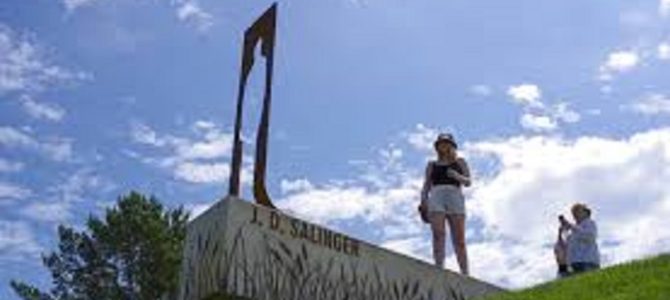
New Attraction in Lithuania: Catcher in the Rye Commemorated by Statue in Sudargas
A new sculpture has gone up to celebrate J. D. Salinger’s novel Catcher in the Rye.
Kenneth Slawenski in his Salinger biography said the family came from Sudargas, a small Jewish village near the Polish-Lithuanian border which belonged to the Russian Empire at the time.
Salinger’s grandfather came from the Sudargas area in the Šakiai district and the statue commemorating Catcher in the Rye was unveiled there in a ceremony held on June 19. A press release for the ceremony said: “The Sudargas area is rich in its history. This was where the book smugglers operated. The famous people who come from here are famous not just in Lithuania, but around the world. We are happy there is yet another attraction where Catcher in the Rye will be commemorated. This will encourage tourists and all of us to remember again this work, and perhaps to read it again. When the novel became popular, our country was occupied. The young people didn’t have a chance to feel the spirit which surrounded the protagonist Holden Caufield in America.”
Sudargas area alderwoman Rita Grigaitienė said the book is still topical among youth because it addresses the problems youth still face. She said adults who read the book will gain insight into the problems young people face.
Full text in Lithuanian here.
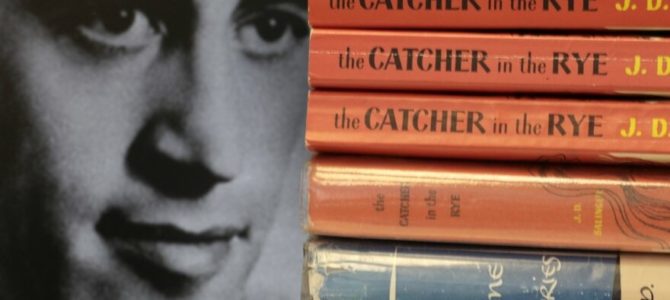
Statue to J. D. Salinger to Appear Near Ancestral Home Friday, June 19
American novelist J. D. Salinger’s novel Catcher in the Rye will be commemorated with a statue near the family’s ancestral home in the Sudargas area of Lithuania Friday. Lithuanian Jewish Community member Geršonas Taicas looked into the man’s genealogy more deeply, using information from Lithuanian and American archives.
The parents of the great-grandfather of Jerome David Salinger were Solomon Zalinger and Sara Kan.

Stop European Holocaust Denial, Focus on Lithuania
Please join us for a special online town hall event Stop European Holocaust Denial Focus: Lithuania co-hosted by ICAN and the American Association of Jewish Lawyers and Jurists (AAJLJ).
Tuesday, June 23, at 8 PM EDT | 5 pm PDT
Watch live!
Facebook: https://www.facebook.com/ICANAction/videos/285276522660390/
YouTube: https://www.youtube.com/watch?v=9v6KNnjikfs
Please join us for a special live event, a virtual town hall featuring Grant Gochin and Silvia Foti speaking about state-sponsored Holocaust denial in Lithuania. Grant Gochin asked the question: “Who actually murdered my family during the Holocaust?” and discovered the fact that the murderer is a current national hero of Lithuania. Silvia Foti was asked by her mother to write the biography of her national hero grandfather, only to discover that he was one of the worst genocidal murderers of Jews during the Holocaust. Silvia Foti’s grandfather murdered Grant Gochin’s family. They have come together to tell the awful truth of how their families have been connected for the past 100 years, and how the Lithuanian government has engaged in a massive cover-up to implement the tenth stage of genocide: denial. In this town hall meeting, we will discuss with Gochin and Foti their paths to discovery of this cover-up, and how it impacts the real world today.
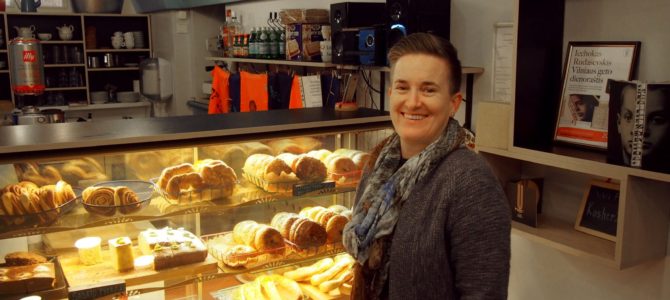
This Country Would Never Have Become the Jerusalem of Lithuania Had It Not Been a Safe and Tolerant Place
Just before quarantine was announced the Bagel Shop received an important visitor. The interview done several months ago remains just as important and perhaps even more so now. We spoke about the importance of ethnic food to Jews living in Lithuania and about a people’s right to have ethnic foods. We await the re-opening of the Bagel Shop Café with bated breath and hope to continue this conversation in front of an audience.
Bagel Shop Interview with Meghan Luckett, Cultural Attaché at the US embassy in Vilnius
Interview by Dovile Rūkaitė, LJC project manager.
Do you like bagels? What’s your favorite kind?
Yes, of course we love bagels. My favorite are everything bagels, we buy them at your bagel shop and in the market and eat them almost every week. We make bagel sandwiches with baked egg, spices and all kinds of stuff. One of our colleagues is a great cook, she makes us homemade bagels. Once we brought her some from Trader Joe’s and she made us excellent everything bagels. My wife is a great cook, she bakes sometimes, but we usually buy them because they are very good.
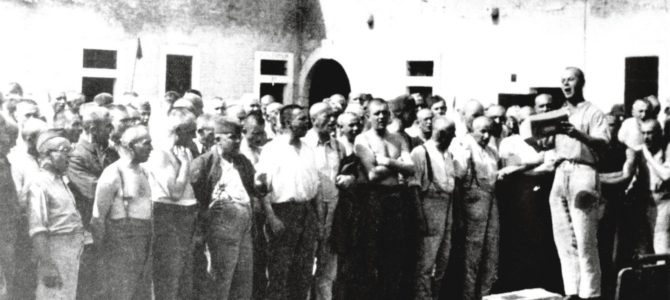
Lithuanian Newspaper Reports on Music of the Holocaust
Lithuania’s Lietuvos Rytas newspaper has published on its website an article about music from the ghettos and camps called “Incredible Weapon Defended People Suffering the Flames of the Hell of Naziism” by Julius Palaima.
§ § §
Six million Jews were horribly murdered in the Holocaust, but the music they created in the concentration camps has survived to today and is now being recreated. It became an exotic refreshment from the murderous reality.
The inscription above the steel gates of the Auschwitz concentration camp says: “Work Sets You Free.” Obviously this was a disgusting lie to hide the blood-curdling truth. One measure, however, helped people escape if only briefly from the horrors of the concentration camp.
It was music. Inmates managed to create even under the most complicated and horrific living conditions. A composer from Italy, Francesco Lotoro, stands at the wheel of the ship conserving this impressive creative work. The man for more than three decades now has been trying to recreate, perform and complete the works of music written under unenviable circumstances. His work is really unique. Lotoro says all of this might never have reached listeners’ ears. “All of this might have disappeared and become lost, but a miracle happened…”
Full text in Lithuanian here.

Parliament’s Ethics Commission Begins Probe into Sieg Heil Salute, Prosecutor Declines
The Lithuanian parliament’s Ethics and Procedures Commission has announced they will investigate what appeared to be two Lithuanian MPs giving one another a Nazi salute during a vote in the National Security and Defense Committee on the Government’s annual report.
Ethics Commission document here.
At the same time police investigators tasked with looking into the same incident by the Vilnius District Prosecutor’s Office announced there was insufficient evidence to begin a criminal investigation. The letter sent by police investigators to the Lithuanian Jewish Community claimed they needed special help from Google, Inc., which was unlikely to cooperate in the matter, that MP Audrys Šimas didn’t know he was being filmed and thus didn’t give a Nazi salute in public, that MP Audrys Šimas denies his gesture was intended to represent the Nazi sieg heil salute, and cites some “right to name” and “right to appearance” in the Lithuanian criminal code as having been violated possibly by whomever decided to place a video recording of the committee meeting on youtube. The letter concludes by suggesting this is a case for the civil courts.
Prosecutor and police investigator’s letter here.
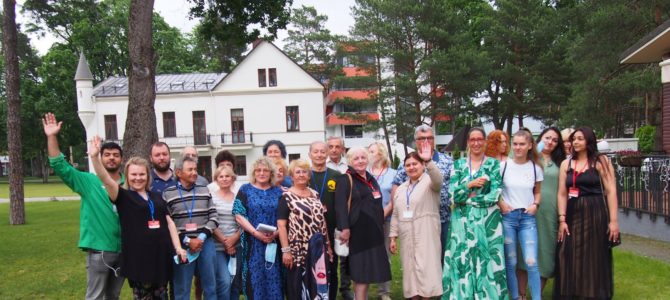
LJC, Roma Social Center, Lithuanian Human Rights Center Coalition to Strengthen Human Rights in Lithuania in 2020
The Lithuanian Jewish Center, the Roma Social Center and Lithuanian Human Rights Center held a workshop in advocacy on June 11 under the “Coalition to Strengthen Human Rights in Lithuania in 2020” project. Advocacy means publicly defending the rights and interests of the public and ethnic communities in this case. LJC and regional Jewish Community members and representatives of the Roma Social Center and Lithuanian Human Rights Center shared strategies and methods for discovering and addressing existing problems and provided real-world examples of successes.
Girvydas Duoblys, the advocacy director for the Galiu gyventi coalition, and Jurgita Poškevičiūtė, a member of the same coalition and the manoteises.lt group, addressed over 40 participants from cities and towns throughout Lithuania. Besides practical and theoretical material, participants also had the opportunity to meet each other and share ideas.
Participants discussed the lack of government reaction to public anti-Semitism and against Roma, extant ethnic stereotypes, the most recent destruction of the Roma camp outside Vilnius causing an increase in homelessness in the Lithuanian capital, illegal actions and discrimination based on ethnicity, commemorating Jewish mass murder sites and ethnic discrimination vis-à-vis Lithuanian citizenship, among other things.
#SkirtingiNeatskirti #CoalitionBuilding
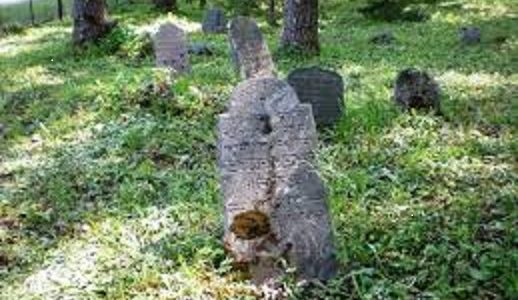
Jewish Culture Week in Krakės: Let’s Learn about the Krakės Jewish Community
Photo: Krakės Jewish cemetery
The Jewish Culture Week in Krakės: Let’s Learn about the Krakės Jewish Community project will take place from June 16 to 18 in Krakės in the Kėdainiai district of Lithuania. More information is available here:
https://www.facebook.com/events/2751960485049357
Robertas Dubinka, director
Krakės Cultural Center
Laisvės alley no. 1, LT – 58242, Krakės, Kėdainiai region
tel. 8 347 38274, mob. 8 615 85084
email: krakiukc@gmail.com

Culture Historian Violeta Davoliūtė’s Population Displacement in Lithuania in the 20th Century
by Jūratė Juškaitė
Historians calculate about 17,000 people were deported from Lithuania during the first Soviet occupation. They were sent into Russia on cattle cars from June 14 to 18, 1941, and many didn’t survive their first winter. Most people who live here know these facts, but the tragedy turns out not to be uniquely Lithuanian.
Violeta Davoliūtė’s book “Population Displacement in Lithuania in the Twentieth Century” was recently completed and will appear soon [it appeared in 2016], in which the culture historian recalls the tragedy and attempts to put the deportation of Jews at the same time within the general Lithuanian context again. She says the story which appeared during the Lithuanian independence movement was ethnocentric and often way too “Catholicized.” Although official commemoration policies appear complex to say the least, and more complicated by the prevailing stereotype of the “Judaeo-Bolshevik,” Davoliūtė says these and similar stereotypes don’t divide deportees, who formed a close-knit community of shared experience.
Full text in Lithuanian here.

Monument to Catcher in the Rye to Rise at Salinger Ancestral Seat
by Jūratė Žuolytė DELFI.lt
The novel Catcher in the Rye by American writer Jerome David Salinger published in 1951 has become well-known around the world and teenage protagonist Holden Caulfield with his unique perspective on events is a household name in at least 24 languages. The author, who passed away in late January, 2010, always avoided fanfare and said little of himself publicly, but his inveterate fans figured out his Livtak forefathers hailed from the Sudargas district of Lithuania, coming to America in the 19th century. Now, this June 19, a monument will be unveiled in the Lithuanian village of the same name to commemorate the author, his works and his roots for future generations.
Two years ago producer Rolandas Skaisgirys, who comes from the same area, came up with the idea to erect the monument . “People have all sorts of idées fixes. Native country is important to everyone, but to me, inside, I always thought home village was more important, I think that’s where everything begins. The Zanavykai region of Šakiai region has many varied cultural and historical memorial sites and many famous people have come from here, for example, I have made documentary films about the signatories to the 1918 Lithuanian Act of Independence Jonas Vailokaitis and Saliamonas Banatis. And then a few years ago Audrius Siaurusevičius told me Salinger’s great-grandfather was from Sudargas, which is close to where I grew up, and then we decided there must be a way to mark this fact, to build a statue or do an installation,” Skaisgirys said. They moved quickly to make this happen with people who felt the same way, including the producers Lauras Lučiūnas and Justinas Garliauskas and others. When they received confirmation from the Sudargas aldermanship expressing high approval for the idea and permission to erect a statue near the Sudargas earthen mound, they contracted sculptor Nerijus Erminas to make the monument.

Rūta Vanagaitė to Launch New Book at Lithuanian Jewish Community
Press release
June 10, 2020
Vilnius
Launch of “How Did It Happen? Christoph Dieckmann Answers to Rūta Vanagaitė”
Dr. Christoph Dieckmann is a prominent German historian and a member of the Lithuanian President’s International Commission for the Evaluation of Crimes Committed by the Nazi and Soviet Occupational Regimes in Lithuania. His monumental study “German Occupation Policy in Lithuania, 1941-1944” (Deutsche Besatzungspolitik in Litauen 1941–1944) was awarded the Yad Vashem International Book Prize for Holocaust Research.
In the new book, controversial Lithuanian writer Rūta Vanagaitė poses a series of questions to Dieckmann in conversations which become too long to call just an interview, conducted over two years. Rūta Vanagaitė taps Christoph Dieckmann’s vast knowledge of the Holocaust throughout Europe to answer the questions which still bother her and presumably other Lithuanian readers who have begun to look seriously at this period of history.
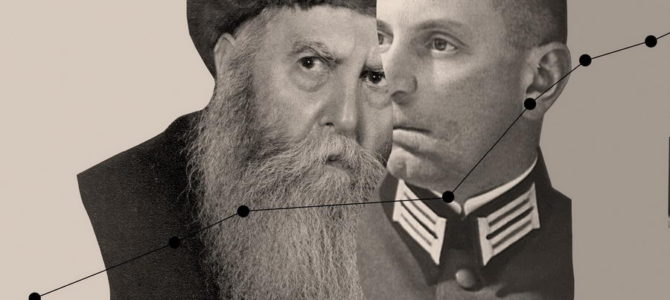
On the Article “Did Kazys Škirpa Rescue a Jewish Rabbi?”
by professor Pinchos Fridberg
Vilnius, obzor.lt
Information for my webpage readers
For your consideration, the article “On the Article ‘Did Kazys Škirpa Rescue a Jewish Rabbi?'”
This article of mine was created simultaneously with the Russian version “По поводу публикации «Kazys Škirpa išgelbėjo žydų rabiną?» Казис Шкирпа спас раввина?” of June 1, 2020, at obzor.lt
You might well ask, “Why did you post a Lithuanian text on a Russian instead of a Lithuanian newspaper internet site?” I will tell you frankly:
Lithuanian sites won’t publish me.
It is a strange thing that the New York Times and Radio Free Europe/Radio Liberty quote me, and yet I am an undesirable author on Lithuanian sites.
Would you believe that in 2013 Artūras Račas, who was then the director of the Baltic News Service news agency, wrote an article about me called “Dear Jewish ‘professor,’ your anti-Semitism is wearisome: dedicated to Pinchos Fridberg” in which he passed on to me some great advice:
“Dear Pinchos, you who call yourself ‘professor,’ …
“stick a gag in your mouth, crawl under the table and be quiet.”

